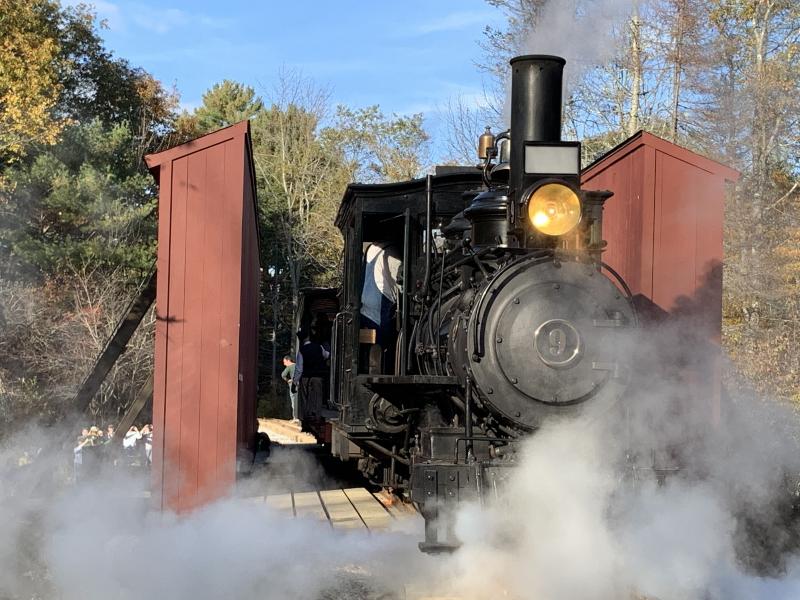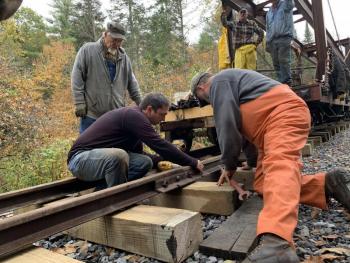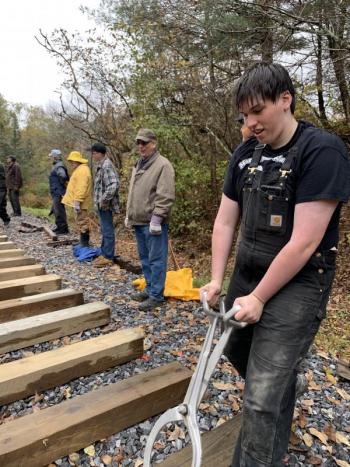Off Route 218 Sunday, No. 9, an 1891 locomotive that last crossed Alna’s Trout Brook in 1933, crossed it again, over a different bridge. And, in a change of plans, No. 9 was on a mission.
Wiscasset, Waterville & Farmington Railway Museum officials showed Wiscasset Newspaper where a piece of rail broke about an hour after being placed Sunday afternoon, on a stretch being built during the nonprofit’s annual fall work weekend. The rail broke, “trapping the work train” that had crossed the new bridge Saturday morning and eight times since, railroad superintendent Jason Lamontagne of Bath said as No. 9 was en route with a flat car carrying a replacement rail. No. 9 was “rescuing” the work train, he said.
Lamontagne said to do it, No. 9 had to leave its passenger cars and crew at a part of the route called Top of the Mountain, then take the flat car down the hill and to the bridge. “Simultaneously, locomotive 3 went to Top of the Mountain from Sheepscot (Station to meet) the passenger train. The passengers weren’t delayed long. As I understand it they were well entertained and jovial.”
Saturday’s and Sunday’s runs took museum-goers to a WW&F first, Lamontagne said: At Top of the Mountain, nearby SeaLyon Farm gave passengers hayrides to the farm’s pumpkin patch. “We’re very proud of that partnership (and) the planning effort required to coordinate those public trains with this massive (track-laying) work effort” going on at the same time, he said. “It was truly major.” The run No. 9 left behind was the day’s last passenger run, Lamontagne said.
Steaming and whistling, No. 9 arrived with the replacement rail shortly before 4 p.m. and, with volunteers watching all around, the only surviving locomotive that ran on the historical WW&F Railway continued onto the bridge.
“How about that? Eighty-six years (since last time),” said longtime volunteer Stewart Rhine of Alna.
Volunteers interviewed both days spoke to the weekend’s significance: The bridge was ready to receive trains. Officials project it will become part of the museum’s ticketed rides in 2021, after ballasts and other work.
Grading a strip of earth off Route 218 Saturday, Mike Fox shared other members’ excitement: “Everything that happens this weekend is special.”
South of the Waterford man, fellow volunteers were measuring and staking the route and laying wooden ties for the track. Black fabric over the ground was to keep weeds out, Connecticut’s Bill Sample explained as Rhode Island’s Rick Sisson hammered in a nail and then a wooden stake. The stakes will help when the track is being aligned, the men said.
“It’s dreams come true time for many,” Sample said about the expansion reaching a milestone with the bridge’s use.
“We’ve been imagining this for a long time,” Sisson said.
Volunteers turned out from several states, museum president David Buczkowski of Alna noted Sunday. He said they were working well together, he was pleased with the progress and was “ecstatic” to see No. 9 on the bridge.
According to museum officials and past Wiscasset Newspaper reports, the donated, 1918 bridge arrived in pieces in October 2017, was rebuilt at the museum and brought north on Route 218 in September 2018.
WW&F Railway ran from 1894 to 1933, Lamontagne said. The museum is 30 this year. The way things turned out Sunday – including getting 214 riders for that day’s pumpkin trips, getting more work done, and then No. 9 saving the day – was “very in keeping” with the museum’s culture, Lamontagne said.
“Loco 9, the railroad coaches and freight cars, the operation, the railway itself, they’re all working parts of a working whole, not just a tribute to the old railway but a continuation of it. The ultimate goal is public service, just like (with the historical railway),” he said Monday.
Frank Robinson, “very retired” engineer from Boston, watched Saturday’s work from a seat on the side. Grandson Joseph Gilbert of Cumberland used a tie tong to help place the wooden ties. Gilbert was working all four days of the work weekend, his grandfather said. “It’s amazing how big a crew they can get. Dedication,” Robinson said.
Gilbert was enjoying the work. “There’s nowhere else in the world you would get to do this.”







































